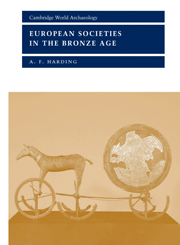Book contents
- Frontmatter
- Contents
- List of figures
- List of tables
- Preface
- 1 Introduction
- 2 The Bronze Age house and village
- 3 Burial
- 4 The domestic economy
- 5 Transport and contact
- 6 Metals
- 7 Other crafts
- 8 Warfare
- 9 Religion and ritual
- 10 Hoards and hoarding
- 11 People
- 12 Social organisation
- 13 The Bronze Age world: questions of scale and interaction
- 14 Epilogue
- References
- Index
7 - Other crafts
Published online by Cambridge University Press: 25 January 2010
- Frontmatter
- Contents
- List of figures
- List of tables
- Preface
- 1 Introduction
- 2 The Bronze Age house and village
- 3 Burial
- 4 The domestic economy
- 5 Transport and contact
- 6 Metals
- 7 Other crafts
- 8 Warfare
- 9 Religion and ritual
- 10 Hoards and hoarding
- 11 People
- 12 Social organisation
- 13 The Bronze Age world: questions of scale and interaction
- 14 Epilogue
- References
- Index
Summary
Metal production was a major preoccupation in the Bronze Age but it was by no means the only one, nor for many people the most important one. Commoner materials were at hand for daily use. Far and away the commonest archaeological material from the period is pottery, though this reflects survival as well as original abundance. On the other hand, the material used in most areas for building construction was wood, though usually only the negative traces of its former existence survive, in the form of post-holes. In areas where stone was available, it was also used, usually in rough form, but for items such as querns and grinders, or for the production of high-quality display items such as mace-heads or battle-axes, it could be finely worked and highly polished to bring out the veining in the material. Leather, bone and antler working were important in most areas, though few detailed studies are available.
Other crafts were also important, notably textile manufacture and glass production. The production and distribution of salt is a crucial (though often forgotten) aspect of life in all societies, and it was no less important in the prehistoric world than in today's. These crafts and industries have left traces of varying extent in the archaeological record.
Potting
In spite of its abundance, little is known about the context of production of Bronze Age pottery. It is not known who made pots (male or female, higher or lower status individuals) or in what situations they were fired, transported around communities, or ‘commoditised’ (see p. 404).
- Type
- Chapter
- Information
- European Societies in the Bronze Age , pp. 242 - 270Publisher: Cambridge University PressPrint publication year: 2000

